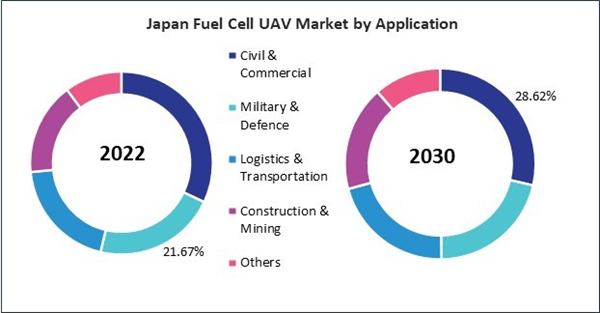The China market dominated the Asia Pacific Fuel Cell UAV Market by Country in 2022, and would continue to be a dominant market till 2030; thereby, achieving a market value of $205.8 million by 2030. The Japan market is registering a CAGR of 13.6% during (2023 - 2030). Additionally, The India market would showcase a CAGR of 15.2% during (2023 - 2030).
In the logistics and transportation sector, fuel cell-powered UAVs have the potential to revolutionize last-mile delivery services, enabling faster, more efficient, and environmentally friendly delivery of goods and parcels. As per the data released in 2023 by the International Trade Administration, in line with the Kingdom’s long-term strategic Vision 2030 program, Saudi Arabia has launched the National Transport and Logistics Strategy to develop and expand transportation in the sea-to-air and rail-to-road connectivity.
Saudi Arabia’s freight and logistics sector is valued at $20.47 billion and is expected to reach $32.12 billion by 2026. Likewise, as per the Government of India, with a 2021 valuation of USD 215 billion, the logistics sector anticipates a promising growth of 10.7% between 2021 and 2026. The Government's bestowed 'infrastructure status' further solidifies its significance.
In addition, the Australian government has been investing heavily in defense modernization programs, aiming to strengthen the country's defense capabilities and enhance its national security posture. As part of this initiative, there has been a growing emphasis on leveraging cutting-edge technologies like fuel cell propulsion systems for UAVs. According to the International Trade Administration data, Australia is spending $200+ Billion on defense acquisition through 2030. Thus, with Asia Pacific's growing construction and defense sectors, the regional market will expand rapidly in the coming years.
Based on Weight, the market is segmented into Less Than 50 Kg, and More Than 50 Kg. Based on Product Type, the market is segmented into Hydrogen Fuel Cell, Proton Exchange Membrane Fuel Cell, and Solid Oxide Fuel Cell. Based on Application, the market is segmented into Civil & Commercial, Military & Defence, Logistics & Transportation, Construction & Mining, and Others. Based on Type, the market is segmented into Rotary Wing, Fixed Wing, and Hybrid. Based on End-Use, the market is segmented into Cargo UAV, and Others. Based on countries, the market is segmented into China, Japan, India, South Korea, Singapore, Australia, and Rest of Asia Pacific.
List of Key Companies Profiled
- Doosan Corporation
- Elbit Systems Ltd.
- The Boeing Company
- Northrop Grumman Corporation
- Textron, Inc.
- AeroVironment, Inc.
- Barnard Microsystems Ltd.
- Horizon Fuel Cell Technologies
- ISS Aerospace
- Plug Power, Inc. (EnergyOR)
Market Report Segmentation
By Weight- Less Than 50 Kg
- More Than 50 Kg
- Hydrogen Fuel Cell
- Proton Exchange Membrane Fuel Cell
- Solid Oxide Fuel Cell
- Civil & Commercial
- Military & Defence
- Logistics & Transportation
- Construction & Mining
- Others
- Rotary Wing
- Fixed Wing
- Hybrid
- Cargo UAV
- Others
- China
- Japan
- India
- South Korea
- Singapore
- Australia
- Rest of Asia Pacific
Table of Contents
Companies Mentioned
- Doosan Corporation
- Elbit Systems Ltd.
- The Boeing Company
- Northrop Grumman Corporation
- Textron, Inc.
- AeroVironment, Inc.
- Barnard Microsystems Ltd.
- Horizon Fuel Cell Technologies
- ISS Aerospace
- Plug Power, Inc. (EnergyOR)
Methodology

LOADING...









